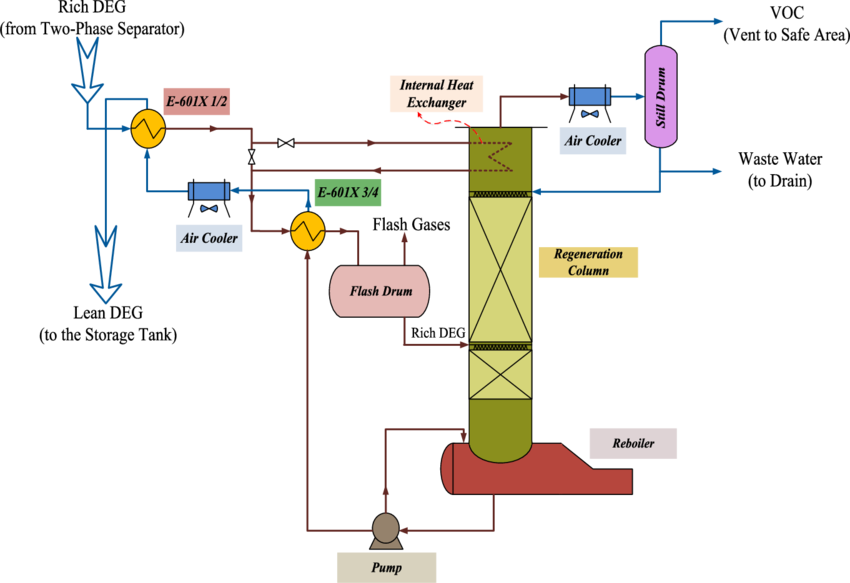
Everyone wants to do a good job or DEG Regeneration Drama
I had just been put in charge of the Facilities Engineering department and I found the job great - working with lots of production, maintenance, and operations people. My manager came to me with an issue that a vendor had not done the work they were supposed to do, took the money for the job, delivered the wrong equipment, and refused to help commission and fix the system. The first step was to figure out what this project was all about. The company was using di-etheylene glycol (DEG) to carry corrosion inhibitor from the wells to the gas treatment facility, as well as binding any free water to avoid hydrates. At the facility the glycol was re-generated by heating the glycol to boil off the water from the glycol (returning it to Lean Glycol). The lean DEG was then returned to the field and re-injected at different wellsites. It was mandated two years previous that the existing DEG regeneration system did not meet standards and would have to be replaced with a new system. The first year this was agreed was a tough one in the industry, so it was almost immediately cut from the budget. The following year it was permitted to have study work done, but at a fraction of the required engineering cost. The year that it was scheduled to be installed, engineering began, and consultants were hired to execute the project and pressure was placed on the organization to get this now hyper-critical regulatory issue dealt with.
The project was a rush job, and everything was designed, constructed and installed on time and slightly under budget. It seemed as if everything was under control and this should be a fairly straight-forward project with only the normal issues to optimize. As far as management was concerned, everything went fine with the project until the new skid was to be started up. When the button was pushed - nothing happened. No drama, no noise, just a system that would not run. Commissioning engineers and production technicians tried multiple fixes and troubleshooting to get the system to run with no success. Most of the project team were contractors, but the commissioning engineer was a company employee and he was responsible for getting this system up and running. I was informed by management to give this person a talking too, as well as the contractors and to get this project “back on track”. This didn’t sound like any fun, but I had a good relationship with the company engineer, and it only took about ten minutes into the conversation for me to realize that he was not the problem. In fact, he had been working ridiculous hours to try and get things working, but as soon as he fixed one issue here, something else would pop-up there. “Ok, I need to talk to the project manager”, I said, “who is that”. The name from the commissioning engineer left me staring blankly – “I have never heard of him?”. “Oh, he left here about nine months ago, just before the engineering manager did”, was the response. “So, who is in charge now”, I asked, and got the laughable response that it was now me (having started the week before). People move on from projects all the time, but it is one aspect that seems to always be pushed to the HR department who is on their own treadmill with their goals to meet. It is ok to change people out (and sometimes beneficial), and I thought the best place to start would be to walk my way backwards through the Management-of-Change (MOC) documents so I could see where the major alterations had been made…except, there were none.
We gave you what you asked for...There were zero management of change forms for this entire project (even the idea of upgrading the DEG system had no MOC because it had been considered a “replacement in kind” and didn’t need it). That could be debated, but to have zero changes on even a relatively small project was “odd”. Again, asking the commissioning engineer I learned that it had been decided no MOC’s were needed because the design and fabrication was being entirely done by the one third-party company so they would handle it. This led to my meeting with the engineering company who was “in charge” of this project. The project was now behind schedule, over budget, causing operational problems, and upper management were looking to inflict maximum pain on the contract company – I was prepared for this meeting, but I wasn’t prepared for the principal contractor’s attitude… “It’s great to meet you and we are happy to hear from your company”, they stated. These people weren’t sneaky or incompetent, and they were quite knowledgeable. In fact they were the market leaders in this type of work and were quite forth coming with any information. Their big question for me was “When do we want to start commissioning?” – to which I replied “You have been trying to commission this for two months, why are you asking me this?” (I could feel my blood pressure rising). Apparently, no-one had contacted them after they delivered the equipment to schedule an install and start-up, so they assumed it was still in the warehouse. But they did not find this strange because they only had one meeting with a consultant engineer before being issued a purchase order and had not been able to reach anyone since, so they built what was requested. That’s great, I said, let’s review the basis of design and see where things have not gone according to plan, and where they generated MOC’s and we can work together to figure things out. They politely refused and I re-phrased the question – they understood the question, but they could not help. I was puzzled and then they informed me there was no Basis of Design – I asked them how could you design something without a basis? They informed me they had asked the same thing when they had been issued a purchase order and they were instructed to design and build what had been discussed in their original meeting with the contract engineer. The service company had very diligently kept that particular e-mail correspondence in anticipation of future problems. The service provider suggested we bring in the project manager into this discussion, and when I informed them he no longer worked here they said that explained why no-one ever answered any technical queries, just e-mails directing them to complete on time (as a side note, the burners never worked because they had been designed for gas flows and pressures from a textbook which gave “typical” values and they were designed using the average numbers). They had done their bit – deliver a piece of equipment, based on a conversation, in a certain time frame. Their continuous requests for direction or clarification had gone unanswered, and their only contact in the company had been gone for almost a year and it had not made any difference.
A project that had no process and no guiding personality
The level of process in every company is different. Some companies are 100% process driven and there is no way to work around a process even when all the logic in the world says you should, and other companies are low on process and high on personality driven work. This was the first time I had encountered a project that had no process and no guiding personality. This project actually happened and went all the way to start-up. There was enough blame to go around on this one. However, if a company promises to design and build a system, and then agrees to do it without sufficient design parameters, they have a responsibility to the people who will operate that equipment, that what they are providing is fit for purpose. It is not always easy to get the right technical information from a customer, but it is always necessary to perform a job diligently. I am a believer in the phrase: “The customer is always right.”, because, if someone is paying for a product or service, it is up to them what they want, however, companies also get to choose who they have for customers. If the difference in ways of working between supplier and customer are too far apart, either of those parties can choose to stop the relationship. I am not a lawyer, and this is not legal advice, it is just my view on how to handle a project that has gone wrong between two parties. Sometimes you have to start over with a blank sheet, and this project was wound back as far as possible. The equipment was taken out of service, the engineering company agreed to provide a partial credit on the equipment skid (and charge for what was re-used) and credit the engineering time (it was never checked), and in exchange the oil company agreed to issue a new contract to them to work together through a project management process to create a design that was fit for purpose. Operations also agreed for the existing system to stay in use until the new system was commissioned (as they agreed this was making the best of a bad situation). I learned to never assume anything (again) and that the relationship between customer and service provider is a two-way street and that if I had a customer which made demands on me or my company that were unworkable, I would have no choice but to not continue, regardless of the short-term business impacts. The oil industry is awesome, and as professionals in the industry, we all have a shared responsibility to provide a sufficient level of thoroughness, regardless of who’s paying the bills.





